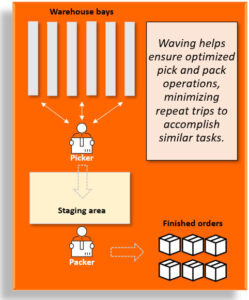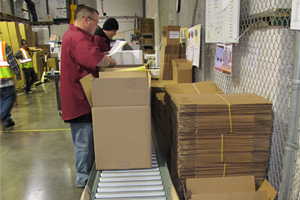While the benefits of wave picking are well known, it may not come as a big surprise that it is still not as widely used as it could be. In some industries, fulfillment requirements are complex and costly, and ad hoc orders are the norm. For fulfillers in such industries, using waving effectively can make fulfillment more efficient. Waving factors may include not only order type (continuity/club vs. ad hoc/daily vs. trade orders), but other key factors such as carrier service level, shipment type (zone skip, temp. controlled, drop ship), container type, and package contents and quantity.
FORT implemented a multi-layered waving solution to enable warehouses to quickly and efficiently group like ad hoc orders, with the following results:
- For warehouses shipping more than 10,000 daily orders a month, average fulfillment time per order decreased by 31%.
- For smaller warehouses, average fulfillment times decreased by over 19%.
The benefits of wave-based fulfillment apply in any industry, and all FORT customers can take advantage of the feature from day one. To find out more about this and other features, contact FORT.
Wave-Picking
At its simplest level, wave picking is all about optimizing the process of picking orders that are ready to be fulfilled. It answers the question, “How can I get this group of orders picked, packed and shipped as efficiently as possible?”
The process itself is relatively simple, and may even be practiced by some who don’t even realize they are engaged in wave picking: A worker will receive a filtered pick list of orders that need to be picked and then moved to the staging or packing area. Instead of walking back and forth for each individual item, the worker groups goods together by specifically defined criteria. Defining these criteria is critical, and they vary by each fulfillment operation and individual business objectives.
The first criterion might be the contents of the package, but could also be the warehouse location of the goods, the zone to which it’s being shipped, the shipping priority or even the carrier that will carry the goods. 
Then, the picker uses a cart or other container to go gather the goods in a single trip. Once completed, each group is sent off to be packaged and shipped. This keeps the orders organized and processed much faster than treating them as ad hoc, “one-off” orders.
Waving picking can be used in both large and small operations.
For fulfillment operations with lower average volumes, wave picking is great for reducing back and forth picking trips for each employee. For facilities with higher volume, it can even out work flow, and help to offset downtime since fewer staff are required during slower periods.
How to Optimize a Wave Picking Strategy
While a wave picking strategy may not be ideal for every fulfillment warehouse (especially those that ship out orders right after they come in), there are a few best practices that will be helpful to keep in mind.
The prerequisite and foundational piece in all of this is a robust warehouse management system. The WMS you use should be able to help determine which variables will be most efficient to use for waving. Out of a large group of unfulfilled orders, for example, your WMS platform should be able to sort and present to you:
- How many have identical contents
- How many are the same order type
- How many have the same courier
- How many have the same service level
- How many have the same requested packing material
- How many have the same depletion location
Any or all of these groups can then be fulfilled as single “waves.”
The simplest way to look at wave picking is that it’s basically the process of picking multiple orders simultaneously. Within a warehouse management system, the same basic concept applies where multiple orders are picked at once to save time.
Warehouse operators first group orders together into a “wave”. These could be small, with only 15- 20 orders or so, or massive, with 1,000+ orders being picked simultaneously.
While there are several different ways to operate a wave, the most common is “Picking Per-Product”, in which the picking and packing processes are split from one another.
Picking by product means that pickers pick stock from the shelves in bulk, and bring it back to some staging area where packers pack orders individually.

For example, say 25 orders all require the same product. The system will tell the picker to go to a single location and pick 25 of that item, then bring it back to the staging area. This is a simple but obvious example of wave picking resulting in overall gains in efficiency; rather than returning to the same location 25 times, the fulfillment staff had to make the trip only once.
The packer then takes one of each of those items from the staging area and adds them to the orders that require that specific product – how this part works depends on the individual business, but generally the orders will be separated by where they’re going so the packer can easily distinguish between each order.
Pros of Wave Picking
- Significant time and money savings if you’re picking many orders that contain the same items.
- Picking and Packing operations are separated out, so the fulfiller has two chances for quality control. This step is also an example of how scanning at multiple points can help increase accuracy and security.
Cons of Wave Picking
- Waving in general requires a bit more floor space, as there is typically a need for a “staging” space between the pick and pack processes.
- It is not necessarily the best approach for all orders. For example, if your warehouse wave picks 500 orders which contain a total of 1,000 different products, it would be extremely difficult for the fulfillment team to locate the correct items for each order within the staging area, much less to make any gains in efficiency.
- The more orders in any given batch are different from each other, the less likely it is that wave picking will create new efficiencies. The final effectiveness of waving is based largely in the extent to which all waved orders contain some fundamental similarity.
Ordering the sequence in which key variables are considered is an interesting and critical part of any waving operation. Waving is not a one-size-fits-all strategy, and there are several possible approaches that need to be considered before implementation:
- Order Type
- Contents (products, quantities)
- Container/Shipper (styrofoam, pulp, wood crate, …)
- Warehouse Depletion and Manifest Location
- Service Level: Ground, overnight
- Shipment Type: temp controlled?
- RSD
FORT has analyzed dozens of fulfillment operations and made recommendations for wave picking and other efficiency-enhancing processes. Should you be thinking about making your operation more efficient, please make sure to reach out and let us know!
